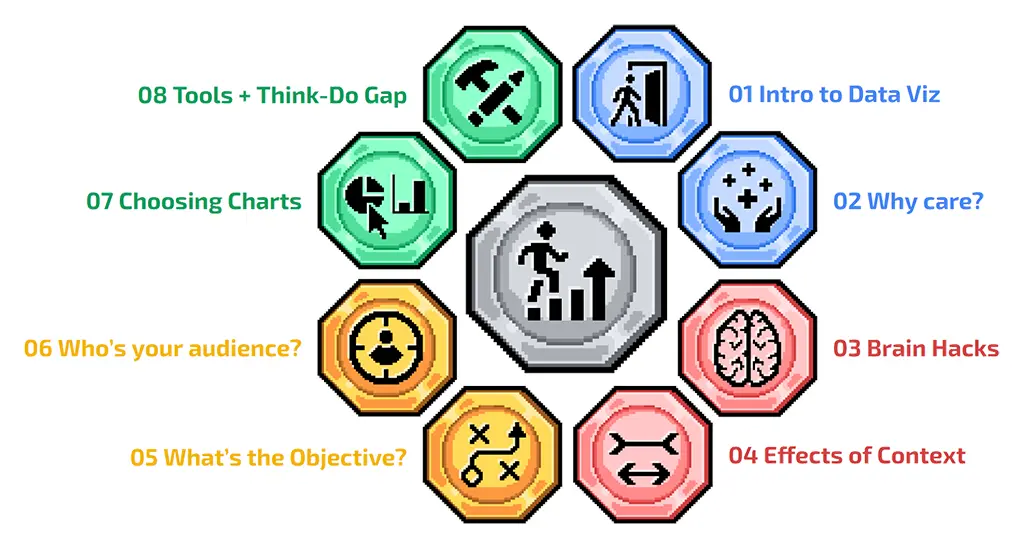Course
Later this year I’m launching my own external video training course for data visualization. I already run several data visualization trainings at my current work, but want to share my knowledge and expertise with the public too.
It will be fun, engaging and accessible for a wide audience. Throughout my career I’ve noticed that nearly everyone can benefit from improving their data visualization skills, not just analysts. As everyone has to visually communicate to their audiences and stakeholders, the more effectively they can do it the more they succeed and help others.
E.g. HR showing the time saving impact of a new training initiative, finance explaining their forecasts to management, sellers pitching the performance uplift of a new product to their clients or briefing contractors on maintenance work for your property.
You will get a solid appreciation and grounding to improve your data visualization skills, along with learning tools and techniques that you can easily apply to your work immediately.
If you would like to be informed when the course is available, please subscribe to the mailing list below:
It’s separate from the general Datasaurus-Rex newsletter mailing list, and will only focus the course.
Later this year I’m launching my own external video training course for data visualization. I already run several data visualization trainings at my current work, but want to share my knowledge and expertise with the public too.
It will be fun, engaging and accessible for a wide audience. Everyone has to visually communicate to their audiences and stakeholders, the more effectively they can do it the more they succeed and help others.
You will get a solid appreciation and grounding to improve your data visualization skills, along with learning tools and techniques that you can easily apply to your work immediately.
If you would like to be informed when the course is available, please subscribe to the mailing list below:
It’s separate from the general Datasaurus-Rex newsletter mailing list, and will only focus the course.
Below is a summary of the 8 sessions the course will cover – each will include practical exercises that you can do, to solidify what you learn in each session. Click or hover over a badge to see what each session will cover in more detail:

Intro to Data Viz
Having an appreciation of where data viz came from and how it has evolved over time into where it is today, will firmly ground what you learn throughout the course and inspire you to improve your skills.
Why Care?
Making charts just "look nice" is not the main goal of data visualization. In this section, you will better appreciate the tangible benefits you can provide both your audiences and yourseleves - which will help you take pride in improving your data viz game for both altruistic and/or selfish reasons.
Brain Hacks
In this section you will see how the human brain developed software to visually spot patterns to survive, that is hard coded into all of us. Then you will learn some common techniques to leverage this, to help your audience see what you want them to see at the right time - critical to data driven storytelling
Effects of Context
In the previous section, we saw how the human brain has evolved to spot visual patterns. In this section we learn that it takes some shortcuts to achieve this, which can lead to the brain getting easily confused visually. With that in mind, you can then learn to avoid them.
What's the Objective?
Here we start to think more critically about what we put on the page, know when to stop building or enhancing a viz and be confident in succeeding to make a good data viz.
Who's Your Audience
Carrying on the strategic block of the course, we focus on having empathy for your target audience. To really think about what would resonate with them best when presenting your insights and bake this awareness into your data viz workflows
Choosing Charts
This section helps you to learn some general rules and techniques to know which charts work better in certain situations. Whilst data visualization is very subjective with no definitively "correct" answers, learning some data visualization "rules of thumb" to help steer your design choices is never a bad thing - especially if you don't know where to start!
Tools + Think-Do Gap
In this section you will be exposed to some of the most common data visualization tools in the market, helping you decide where you want to deep dive next. You'll also learn that the tool itself matters far less compared to what you are most comfortable in using - the less process friction you have to implement good data viz best practice the better.

INTRO TO DATA VIZ
Having an appreciation of where data viz came from and how it has evolved over time into where it is today, will firmly ground what you learn throughout the course and inspire you to improve your skills.

WHY CARE?
Making charts just "look nice" is not the main goal of data visualization. In this section, you will better appreciate the tangible benefits you can provide both your audiences and yourseleves - which will help you take pride in improving your data viz game for both altruistic and/or selfish reasons.

Brain Hacks
in this section you will see how the human brain developed software to visually spot patterns to survive, that is hard coded into all of us. Then you will learn some common techniques to leverage this, to help your audience see what you want them to see at the right time - critical to data driven storytelling

Effects of Context
In the previous section, we saw how the human brain has evolved to spot visual patterns. In this section we learn that it takes some shortcuts to achieve this, which can lead to the brain getting easily confused visually. With that in mind, you can then learn to avoid them.

What's the Objective
Here we start to think more critically about what we put on the page, know when to stop building or enhancing a viz and be confident in succeeding to make a good data viz.

Who's Your Audience?
Carrying on the strategic block of the course, we focus on having empathy for your target audience. To really think about what would resonate with them best when presenting your insights and bake this awareness into your data viz workflows

Choosing Charts
This section helps you to learn some general rules and techniques to know which charts work better in certain situations. Whilst data visualization is very subjective with no definitively "correct" answers, learning some data visualization "rules of thumb" to help steer your design choices is never a bad thing - especially if you don't know where to start!

Tools + Think-Do Gap
In this section you will be exposed to some of the most common data visualization tools in the market, helping you decide where you want to deep dive next. You'll also learn that the tool itself matters far less compared to what you are most comfortable in using - the less process friction you have to implement good data viz best practice the better.
If you would like to be informed when the course is available, please subscribe to the mailing list below:
It’s separate from the general Datasaurus-Rex newsletter mailing list, and will only focus the course.